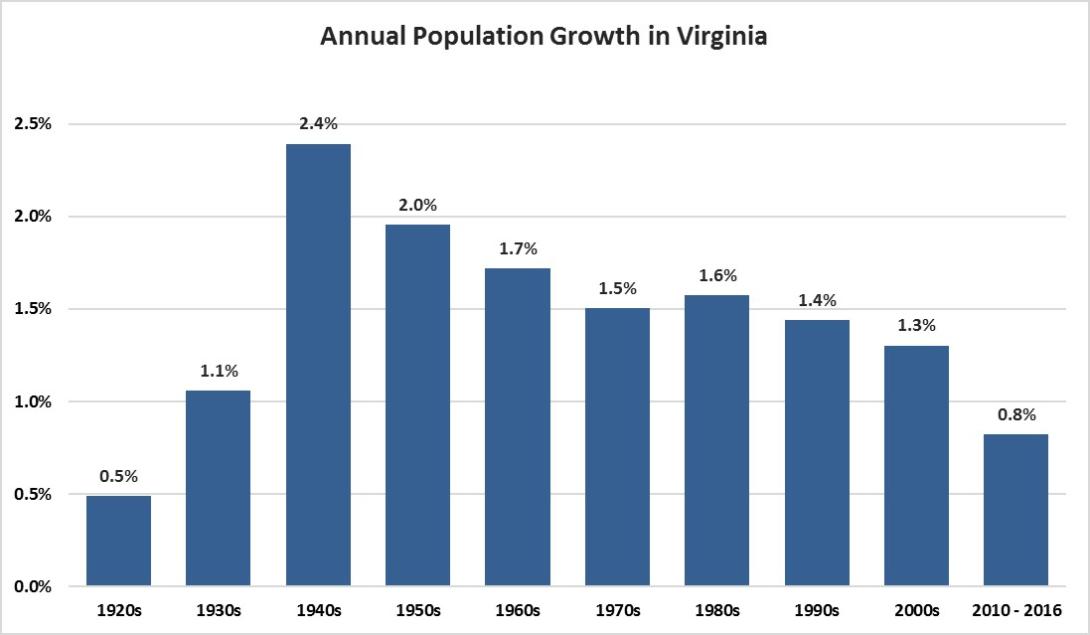Virginia’s population is growing at its slowest pace since the 1920s
This morning the Weldon Cooper Center at the University of Virginia released its 2016 population estimates for Virginia’s counties and cities. The most obvious trend in the population estimates is how much more slowly Virginia and most of its communities are growing this decade. Since 2010, Virginia’s population has grown by a little over 410,000 residents. During the same period of the last decade, Virginia added over 604,000 residents.

As last week’s post noted, Virginia’s population growth is slowing in large part because many of its residents are leaving the state. The last time Virginia grew at a rate that was slow as the rate it is experiencing now was during the 1920s, which was also the last time many Virginians were leaving the commonwealth for other states.

Though slow population growth and out-migration are new demographic trends in Virginia, most states north of Virginia have been experiencing both trends for years. In recent decades, Virginia’s population growth easily out-paced its northern neighbors, growing at rates similar to Georgia and the Carolinas. But since 2010, Virginia’s population growth has become more like Maryland and Delaware, increasing at a slower rate with many residents moving south to states with warmer climates, lower costs of living, and faster growing economies.
The polarization of population growth in Virginia
Due, in part, to the economic impact of the federal budget sequestration, more people in Northern Virginia are leaving the state, which is the predominant reason for the recent shift to more people moving out of – rather into – Virginia. Yet, counterintuitively, Northern Virginia’s share of the state’s population growth has increased from 55 percent between 2000 and 2006 to 63 percent since 2010. Because of Northern Virginia’s large young population, the region has far more births than deaths, and continues to grow even with people leaving the region. In the last decade, counties in the rest of Virginia attracted most people moving out of Northern Virginia, but now more Northern Virginians are moving out of Virginia altogether, helping slow the rest of Virginia’s population growth.
This decade, population growth across Virginia has been more concentrated in its largest urban areas. Since 2010, the share of Virginia’s total population growth in the three largest metro areas in Virginia- Northern Virginia, Richmond and Hampton Roads – rose to 93 percent, up from 81 percent between 2000 and 2006. Similarly, in this decade only 9 of Virginia’s 95 counties have grown by more than 1 percent annually, while 43 counties grew more than 1 percent annually during the same period of the last decade.
Outside Virginia’s largest metro areas, the slowdown in population growth has increasingly turned into population decline, with 45, mostly rural, Virginia counties declining in population since 2010. Fewer people, particularly families moving into rural Virginia communities in recent years have helped slow growth. An aging population has also resulted in more deaths in rural communities and fewer births. Since 2011, Virginia has had more deaths than births outside its three largest metro areas. On the longer term, an aging population will likely further slow population growth across Virginia. Just in the past eight years, the difference between the number of births and deaths in Virginia shrunk by a quarter or 12,000 individuals.
Population Growth by Virginia Region
While slowing population growth has been a predominant demographic trend in Virginia so far this decade, Virginia’s cities have often been an exception, with most cities growing faster this decade than during the last. As the chart above shows, in nearly every Virginia region, cities have contributed to a larger share of population growth so far this decade. Not only have many of Virginia’s large cities experienced a resurgence in population growth, such as Richmond and Roanoke, but also many smaller Virginia cities, including Falls Church and Charlottesville. In many Virginia cities, birth rates and student enrollment have also grown since 2010, suggesting that the rise in their populations has been fueled in large part by more families staying in cities to raise their children.
While population growth continues or accelerates in most of Virginia’s urban areas, much of rural Virginia will likely continue to experience slow population growth or decline during this decade. Developing effective statewide and regional policies that account for the polarization in Virginia’s demographic trends will likely only become more difficult.


